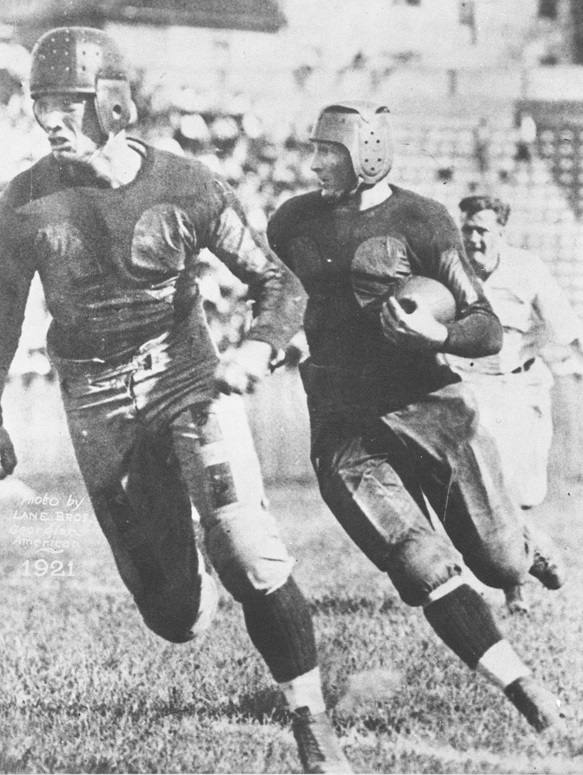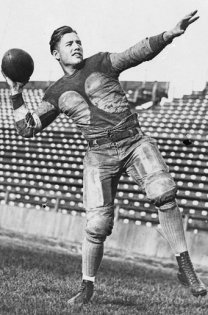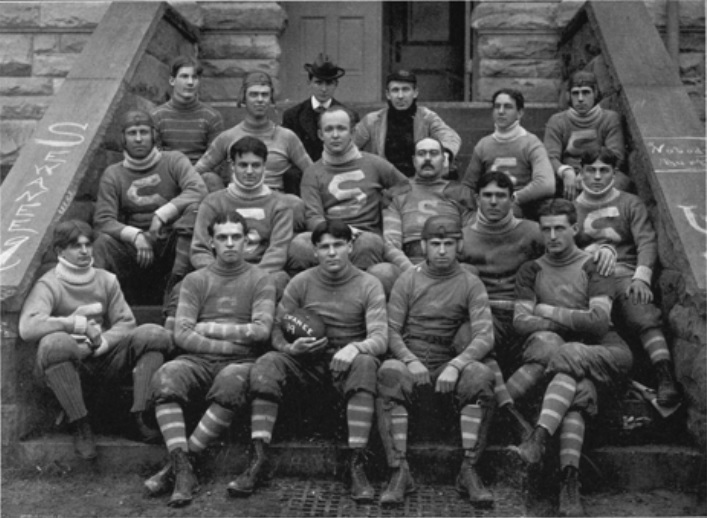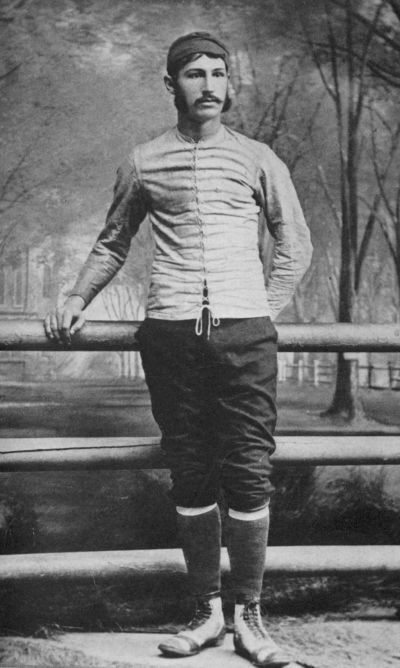|
1921 Georgia Tech Golden Tornado Football Team
The 1921 Georgia Tech Golden Tornado football team represented the Georgia Tech Golden Tornado of the Georgia Institute of Technology during the 1921 Southern Intercollegiate Athletic Association football season. The Golden Tornado played its home games at Grant Field. The Golden Tornado was coached by William Alexander in his second year as head coach, compiling an 8–1 record (5–0 against Southern Intercollegiate Athletic Association (SIAA) teams) and outscoring opponents 360 to 56. The team beat Rutgers and its only loss was its only road game, at the Polo Grounds in New York City, to undefeated eastern power Penn State. Defeating the rival Auburn Tigers secured a sharing of the SIAA title with the Georgia Bulldogs and Vanderbilt Commodores, though "no championship was ever won with less effort or achievement." noted sportswriter Fuzzy Woodruff. Captain Judy Harlan made Walter Camp's third-team All-America. Red Barron led the team in scoring and rushed for 1,459 yards ... [...More Info...] [...Related Items...] OR: [Wikipedia] [Google] [Baidu] |
William Alexander (American Football)
William Anderson Alexander (June 6, 1889 – April 23, 1950) was an American football player and coach. He served as the head football coach at the Georgia Institute of Technology from 1920 to 1944, compiling a record of 134–95–15. Alexander has the second most victories of any Tech football coach. Alexander's 1928 Georgia Tech Yellow Jackets have been recognized as national champions by a number of selectors. Alexander was the first college football coach to place his teams in the four major post-season bowl games of the time: Sugar, Cotton, Orange and Rose. His teams won three of the four bowls. The 1929 Rose Bowl win, which earned his team the national championship, is the most celebrated because of the wrong-way run by California's Roy Riegels. Alexander was also the head basketball coach at Georgia Tech for four seasons from 1919 to 1924. He was inducted into the College Football Hall of Fame as a coach in 1951. Player Alexander played football under John Heisman and wa ... [...More Info...] [...Related Items...] OR: [Wikipedia] [Google] [Baidu] |
Fuzzy Woodruff
Lorenzo Ferguson "Fuzzy" Woodruff (May 27, 1884 – December 7, 1929) was an early 20th-century American sportswriter known throughout most of the southeast for his vivid writing. He was also a music and drama critic. He began his newspaper career as a member of the ''Montgomery Advertiser'' in 1907. Among the newspapers he served were the '' Birmingham News'', the '' Birmingham Age-Herald'', the ''New Orleans States'', the '' Mobile Register'', the '' New York Evening World'', the '' Chicago Inter-Ocean'', the '' Chicago Examiner'', the ''St. Louis Dispatch'', the ''Atlanta Constitution'', the '' Atlanta Georgian'', and the ''Atlanta Journal''. College football Recalling the only game in which the 'Iron Men' of the undefeated 1899 Sewanee Tigers football team, who won five road games in six days, were scored upon–by John Heisman's Auburn team in a close 11 to 10 win, Woodruff wrote:Under Heisman's tutelage, Auburn played with a marvelous speed and dash that couldn't ... [...More Info...] [...Related Items...] OR: [Wikipedia] [Google] [Baidu] |
Touchdown
A touchdown (abbreviated as TD) is a scoring play in gridiron football. Whether running, passing, returning a kickoff or punt, or recovering a turnover, a team scores a touchdown by advancing the ball into the opponent's end zone. In American football, a touchdown is worth six points and is followed by an extra point or two-point conversion attempt. Description To score a touchdown, one team must take the football into the opposite end zone. In all gridiron codes, the touchdown is scored the instant the ball touches or "breaks" the plane of the front of the goal line (that is, if any part of the ball is in the space on, above, or across the goal line) while in the possession of a player whose team is trying to score in that end zone. This particular requirement of the touchdown differs from other sports in which points are scored by moving a ball or equivalent object into a goal where the whole of the relevant object must cross the whole of the goal line for a score to be a ... [...More Info...] [...Related Items...] OR: [Wikipedia] [Google] [Baidu] |
American Football Positions
In American football, the specific role that a player takes on the field is referred to as their "position". Under the modern rules of American football, both teams are allowed 11 players on the field at one time and have "unlimited free substitutions", meaning that they may change any number of players during any "dead ball" situation. This has resulted in the development of three task-specific "platoons" of players within any single team: the offense (the team with possession of the ball, which is trying to score), the defense (the team trying to prevent the other team from scoring, and to take the ball from them), and the so-called 'special teams' (who play in all kicking situations). Within these three separate "platoons", various positions exist depending on the jobs that the players are doing. Offense In American football, the offense is the team that has possession of the ball and is advancing toward the opponent's end zone to score points. The eleven players of the offen ... [...More Info...] [...Related Items...] OR: [Wikipedia] [Google] [Baidu] |
American Football
American football (referred to simply as football in the United States and Canada), also known as gridiron, is a team sport played by two teams of eleven players on a rectangular field with goalposts at each end. The offense, the team with possession of the oval-shaped football, attempts to advance down the field by running with the ball or passing it, while the defense, the team without possession of the ball, aims to stop the offense's advance and to take control of the ball for themselves. The offense must advance at least ten yards in four downs or plays; if they fail, they turn over the football to the defense, but if they succeed, they are given a new set of four downs to continue the drive. Points are scored primarily by advancing the ball into the opposing team's end zone for a touchdown or kicking the ball through the opponent's goalposts for a field goal. The team with the most points at the end of a game wins. American football evolved in the United States, ... [...More Info...] [...Related Items...] OR: [Wikipedia] [Google] [Baidu] |
One-platoon System
The one-platoon system, also known as iron man football, is a platoon system in American football where players play on both offense and defense. It was the result of smaller roster sizes in the early days of the game and rules that limited player substitutions, rules that are also standard procedure in many other sports but were eliminated in the 1940s as free substitution was legalized. The alternative system is the two-platoon system (or simply the ''platoon system''), which uses separate offensive and defensive units (three platoons if special teams is also counted). Each system was used at different times in American college football and in the National Football League. One-platoon football is seen in modern times mostly on lower-end and smaller teams at the high school and semi-pro levels, where player shortages and talent disparities require it; the system allows teams to play with a smaller roster than a two-platoon or multiple-platoon team, but because players are on the f ... [...More Info...] [...Related Items...] OR: [Wikipedia] [Google] [Baidu] |
College Football All-Southern Team
The College Football All-Southern Team was an all-star team of college football players from the Southern United States. The honor was given annually to the best players at their respective positions. It is analogous to the All-America Team and was most often selected in newspapers. Notable pickers of All-Southern teams include John Heisman, Dan McGugin, George C. Marshall, Grantland Rice, W. A. Lambeth, Reynolds Tichenor, Nash Buckingham, Innis Brown, and Dick Jemison. Football in the south Princeton's 115-0 drubbing of Virginia in 1890 marked football's arrival in the south. Conference play Major football programs in the South used to include: members of the Southern Intercollegiate Athletic Association (SIAA), the conference representative of the Deep South and used more strictly to mean the South east of Vanderbilt University in Nashville, the predecessor to today's Southeastern Conference (SEC, which originally represented the Southern states west and south of the Appalac ... [...More Info...] [...Related Items...] OR: [Wikipedia] [Google] [Baidu] |
Oscar Davis (American Football)
Oscar Davis was an American football guard for the Georgia Tech Yellow Jackets of the Georgia Institute of Technology. He was selected All-Southern and is a member of the Tech Athletics Hall of Fame and Tech All-Era Team ( William Alexander Era). Davis was selected All-American in 1922 by Lawrence Perry and Billy Evans William George Evans (February 10, 1884 – January 23, 1956), nicknamed "The Boy Umpire", was an American umpire in Major League Baseball who worked in the American League from 1906 to 1927. He became, at age 22, the youngest umpire in majo .... References American football guards All-American college football players All-Southern college football players Georgia Tech Yellow Jackets football players {{collegefootball-player-stub ... [...More Info...] [...Related Items...] OR: [Wikipedia] [Google] [Baidu] |
Albert Staton
Albert Hammond Staton (December 4, 1899 – January 15, 1980) was a college football and basketball player for the Georgia Tech Yellow Jackets of the Georgia Institute of Technology, and a Coca-Cola executive in Colombia. Early years Albert Staton was born on December 4, 1899 in Attalla, Alabama, the son of John Curtis Staton and Bivien Hammond Staton. He attended Boys High School in Atlanta, Georgia. Georgia Tech Staton graduated with a mechanical engineering degree from Georgia Tech. He was a prominent end for the Georgia Tech football team. He was selected All-Southern every year he played, and picked for its All-Era Team. Albert played with his brother John. In 1921, Staton was captain of the basketball team. Staton was elected into the Georgia Tech Athletics Hall of Fame in 1963. Al Staton was the first chief executive officer of the Alumni Association and editor of its magazine. He could also sing, a baritone. Coca-Cola He worked for the Coca-Cola company in ... [...More Info...] [...Related Items...] OR: [Wikipedia] [Google] [Baidu] |
John Staton
John Curtis Staton (June 9, 1902 – September 16, 1990) was a college football player and Coca-Cola executive. Early years John Curtis Staton was born June 9, 1902, in Atlanta, the son of John Curtis Staton and Bivien Hammond Staton. He attended Boys High School. Georgia Tech Staton was an All-Southern end for William Alexander's Georgia Tech Yellow Jackets of the Georgia Institute of Technology. He played with his brother Albert Staton, and also played basketball, track, and swimming. John was elected to the Georgia Tech Athletics Hall of Fame in 1965. He was a member of the Kappa Sigma Kappa Sigma (), commonly known as Kappa Sig, is an American collegiate social fraternity founded at the University of Virginia in 1869. Kappa Sigma is one of the five largest international fraternities with currently 318 active chapters and colo ... fraternity. Coca-Cola Staton then joined Coca-Cola in 1924, becoming vice president before retiring in 1968. It was said it was him who ... [...More Info...] [...Related Items...] OR: [Wikipedia] [Google] [Baidu] |
Rush (gridiron Football)
Rushing is an action taken by the offense that means to advance the ball by running with it, as opposed to passing, or kicking. Running Rushing, on offense, is running with the ball when starting from behind the line of scrimmage with an intent of gaining yardage. While this usually means a running play, any offensive play that does not involve a forward pass is a rush - also called a run. It is usually done by the running back after a handoff from the quarterback, although quarterbacks and wide receivers can also rush. The quarterback will usually run when a passing play has broken down – such as when there is no receiver open to catch the ball – and there is room to run down the field. A team with a quarterback who is fast and skilled at running may regularly call intentional running plays for that quarterback, but this is rare due to the increased risk of injury. A wide receiver can act as a rusher on several kinds of plays, such as on a reverse, on an end-around, ... [...More Info...] [...Related Items...] OR: [Wikipedia] [Google] [Baidu] |






